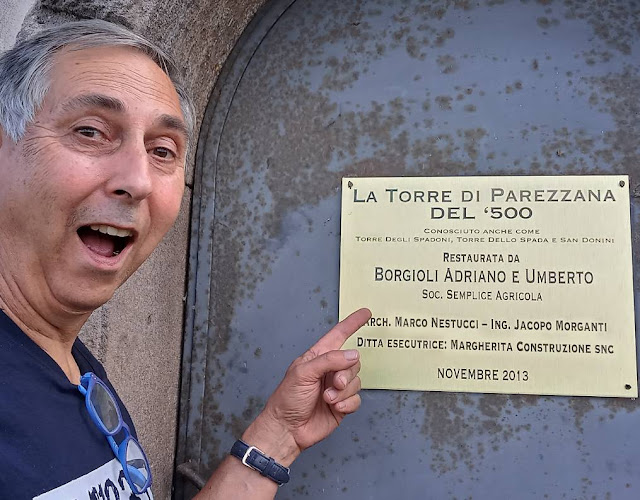Breaking news! The Spadoni/Spada/Sandonnini tower is going to get a second makeover next year. After falling into disrepair for hundreds of years, the tower received a much-needed facelift in 2013—and now the Comune di Capannori has decided that was not enough and is set to spend another 150,000 euro.
 |
| From Luccaindiretta.it |
 |
| Me at the tower in 2015. |
The tower is owned by the family of Umberto Borgioli,
and he enthusiastically endorses the project. “We are satisfied with
the synergy created with the municipality for the presentation of the
redevelopment project,” Borgioli said. “Although the Torre dello Spada is owned
by us, we consider it a monument of great symbolic value for the territory of
Capannori and for its rural heritage and therefore of the public. Our family
has always had great affection for Parezzana and for the tower, and therefore
it is important for us to preserve and enhance this monument. On our part,
there is the utmost willingness to undertake a path with the municipality and
associations to ensure the opening of the tower at least on some days of the
year to make it open and accessible.”
Historian Nicola Laganà also spoke at the city
meeting, explaining that the tower was built between the 1400s and 1500s. I had
hoped that he would be able to shed further light on how the tower acquired its
several names, but the article only said he believed it to have been built by
the Sandonnini family and that it perhaps later came under the ownership of the
Spada family. Both of these families had wealthy and noble branches in the
Lucca area during the middle ages and beyond, and the tower is located on via
Dello Spada. While the Spadoni name enters is not mentioned, my own
personal opinion is that Spadone was the nickname of a member of the Spada family
tied to the tower, and that his heirs took on the surname Spadoni. I have
written more about this theory in Is
the Tuscan surname Spadoni tied to the wealthy Spada family of Lucca?
 |
| The tower is roughly in the northern area of what once was the Lago di Bientina. |
Laganà did offer some hypotheses on the original function of the tower, though that too is still a matter for debate. He said some maintain it was born as a lighthouse in a swampy area, others that it was a watchtower to guard the territory from the incursions of the Florentine army, and still others maintain it was an agricultural depot. Looking at old maps of the area, I believe the lighthouse theory to be most likely, as the tower is in an area that ancient maps show as the Lago di Bientina (also sometimes called Lago Sesto), a lake that no longer exists, though the land around the tower is flat and becomes swampy during heavy winter rains. An extensive series of ditches and canals rendered the lake extinct several hundreds of years ago.
In any event, and for obvious reasons, I prefer the
name Torre degli Spadoni, and I’m delighted to see that it is being further
restored. It has the potential to become a popular tourist attraction and is
certainly an important part of the area’s history, even if we don’t know for
certain exactly how that part played out. Maybe I just need to make up a good
story about how my Spadoni ancestors saved the city of Lucca by turning off the
watchtower light at an opportune moment, thus drowning an invading army from
Pisa. I suspect that history already has a number of heroic stories that never
truly took place, so what harm can one more do? File it under future projects?



.jpg)


.jpg)
.jpg)



.jpg)